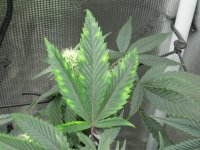I would give it a good soak and rinse before using it to get rid of possible sodium.There's a lot of powder in my bird's 'oyster shell' bag. The label says that it is oyster shell, coral, and clam shell. Can this powder, that is usually a waste, be used in these simple organic mixes?
-
ICMag with help from Landrace Warden and The Vault is running a NEW contest in November! You can check it here. Prizes are seeds & forum premium access. Come join in!
You are using an out of date browser. It may not display this or other websites correctly.
You should upgrade or use an alternative browser.
You should upgrade or use an alternative browser.
Tutorial Organics for Beginners
- Thread starter BurnOne
- Start date
Chickens cannot tolerate much salt, so i would think that there isn't very darn much in there, but thanks for that advise, chilliwilli, I think that i'll err on the side of caution and rinse, (like you said)first. Though, i'm a little confused how to rinse a fine powder. Maybe soak, then strain it through an old flour sack towel.
Should work that way imo. Or mix in a bucket with water, let it settle and then tilt to drain. Maybe repeate 2 or 3 times.Chickens cannot tolerate much salt, so i would think that there isn't very darn much in there, but thanks for that advise, chilliwilli, I think that i'll err on the side of caution and rinse, (like you said)first. Though, i'm a little confused how to rinse a fine powder. Maybe soak, then strain it through an old flour sack towel.
Bio boy
Active member
Boiling it will help of concerned with salt the oyster shell settles at the bottom it takes months to break down so suck water off dry out and bobs your uncleShould work that way imo. Or mix in a bucket with water, let it settle and then tilt to drain. Maybe repeate 2 or 3 times.
thugpoet
Active member
Hi all,
Starting my first supersoil grow. I am trying to figure out how to adapt the LC recipes for my run, and would appreciate some input from those who are experienced in this method of feeding.
So as far as the soil mix, I've decided on: 40% coco, 30% compost, 10% worm castings and 20% perlite.
I got the compost from a landscaping company for a real good deal and it comes with a fact sheet of what's in there> N: 1.8 | P: 0.73 | K: 1.4 | Ca: 3 | Mg: 0.9 | PH : 7.78.
It's a pretty rich compost with lots of humates.
So to follow the LC recipe ratios for bloom mixes (80-90% NLD genes so lower on Nitrogen), I'm thinking of adding the following amendments (for 1 Gallon of soil):
- 1 Tsp of Kelp Meal DTE (1-0.1-2)
- 0.3 Tsp of Alfalfa DTE (2.5-0.5-2.5)
- 0.02 Tsp of Blood Meal DTE (12-0-0)
- 0.5 Tsp of Seabird Guano DTE (0-11-0)
- 0.5 Tsp of Organic Greensand Old Cobblers Farm (0-0-3)
- 1 Tsp of (Prilled) Dolomite Limel DTE for the CAL MAG (which coco and LED grows require more of than otherwise)
That brings me to an NPK ratio of 1.99 – 5.75 – 4.25. 1-3-2 is what is recommended for bloom in this thread.
I'll probably add more Seabird Guano in flower to meet the P needs.
I see some people doing stuff like 2 Tsp of Blood Meal, 2 Tsp of Bone Meal and 1 Tsp of KELP. Isn't that way out of balance with ratios? Seems very heavy in Nitrogen.
My main concern is whether my recipe is way too light of a mix? Should I increase the amount of amendments while keeping the same ratios, or just give it a try as is and supplement as needed based on how the plants react?
My experience with feeding has been that you typically want to start with half of the recommended doses and take it from there. I used to grow Hydro with ECs of around 1.0 to 1.4.
Also, I've noticed that a lot of these amendments have so much Calcium in them, I know cannabis plants need a lot of calcium, but not more than they need NPK.
From my understanding, too much calcium can lock out other nutrients, is that ever a concern?
Cannamicably,
Thug
Starting my first supersoil grow. I am trying to figure out how to adapt the LC recipes for my run, and would appreciate some input from those who are experienced in this method of feeding.
So as far as the soil mix, I've decided on: 40% coco, 30% compost, 10% worm castings and 20% perlite.
I got the compost from a landscaping company for a real good deal and it comes with a fact sheet of what's in there> N: 1.8 | P: 0.73 | K: 1.4 | Ca: 3 | Mg: 0.9 | PH : 7.78.
It's a pretty rich compost with lots of humates.
So to follow the LC recipe ratios for bloom mixes (80-90% NLD genes so lower on Nitrogen), I'm thinking of adding the following amendments (for 1 Gallon of soil):
- 1 Tsp of Kelp Meal DTE (1-0.1-2)
- 0.3 Tsp of Alfalfa DTE (2.5-0.5-2.5)
- 0.02 Tsp of Blood Meal DTE (12-0-0)
- 0.5 Tsp of Seabird Guano DTE (0-11-0)
- 0.5 Tsp of Organic Greensand Old Cobblers Farm (0-0-3)
- 1 Tsp of (Prilled) Dolomite Limel DTE for the CAL MAG (which coco and LED grows require more of than otherwise)
That brings me to an NPK ratio of 1.99 – 5.75 – 4.25. 1-3-2 is what is recommended for bloom in this thread.
I'll probably add more Seabird Guano in flower to meet the P needs.
I see some people doing stuff like 2 Tsp of Blood Meal, 2 Tsp of Bone Meal and 1 Tsp of KELP. Isn't that way out of balance with ratios? Seems very heavy in Nitrogen.
My main concern is whether my recipe is way too light of a mix? Should I increase the amount of amendments while keeping the same ratios, or just give it a try as is and supplement as needed based on how the plants react?
My experience with feeding has been that you typically want to start with half of the recommended doses and take it from there. I used to grow Hydro with ECs of around 1.0 to 1.4.
Also, I've noticed that a lot of these amendments have so much Calcium in them, I know cannabis plants need a lot of calcium, but not more than they need NPK.
From my understanding, too much calcium can lock out other nutrients, is that ever a concern?
Cannamicably,
Thug

BuckeyeGreen
Well-known member
My last run I used LC’s Soilless Mix #2 and Recipe #1. I followed the direction exactly and it worked like a charm. No problems with any nutrient deficiencies, fungal issues, bugs, nothing. I added RO water only for the whole grow and it was the easiest grow I’ve ever done. I had 4 plants in 3 gallon pots and they finished in about 60 days and another sativa in a 6 gallon pot and it flowered for 110 days with no nutrient deficiencies at all.
His suggestions do work and of course you change whatever you want but if you want a very easy grow, follow his directions and you will have no problems.
His suggestions do work and of course you change whatever you want but if you want a very easy grow, follow his directions and you will have no problems.
OG_NoMan
Not Veteran
From my limited understanding you shouldn't count the calcium in most amendments because the calcium is in there for the chemical reactions needed to provide the npk numbers on the bag and is not soluble calcium. In your list of amendments I would only count the lime for calcium content. Best of luck and maybe someone with more experience will chime inHi all,
Starting my first supersoil grow. I am trying to figure out how to adapt the LC recipes for my run, and would appreciate some input from those who are experienced in this method of feeding.
So as far as the soil mix, I've decided on: 40% coco, 30% compost, 10% worm castings and 20% perlite.
I got the compost from a landscaping company for a real good deal and it comes with a fact sheet of what's in there> N: 1.8 | P: 0.73 | K: 1.4 | Ca: 3 | Mg: 0.9 | PH : 7.78.
It's a pretty rich compost with lots of humates.
So to follow the LC recipe ratios for bloom mixes (80-90% NLD genes so lower on Nitrogen), I'm thinking of adding the following amendments (for 1 Gallon of soil):
- 1 Tsp of Kelp Meal DTE (1-0.1-2)
- 0.3 Tsp of Alfalfa DTE (2.5-0.5-2.5)
- 0.02 Tsp of Blood Meal DTE (12-0-0)
- 0.5 Tsp of Seabird Guano DTE (0-11-0)
- 0.5 Tsp of Organic Greensand Old Cobblers Farm (0-0-3)
- 1 Tsp of (Prilled) Dolomite Limel DTE for the CAL MAG (which coco and LED grows require more of than otherwise)
That brings me to an NPK ratio of 1.99 – 5.75 – 4.25. 1-3-2 is what is recommended for bloom in this thread.
I'll probably add more Seabird Guano in flower to meet the P needs.
I see some people doing stuff like 2 Tsp of Blood Meal, 2 Tsp of Bone Meal and 1 Tsp of KELP. Isn't that way out of balance with ratios? Seems very heavy in Nitrogen.
My main concern is whether my recipe is way too light of a mix? Should I increase the amount of amendments while keeping the same ratios, or just give it a try as is and supplement as needed based on how the plants react?
My experience with feeding has been that you typically want to start with half of the recommended doses and take it from there. I used to grow Hydro with ECs of around 1.0 to 1.4.
Also, I've noticed that a lot of these amendments have so much Calcium in them, I know cannabis plants need a lot of calcium, but not more than they need NPK.
From my understanding, too much calcium can lock out other nutrients, is that ever a concern?
Cannamicably,
Thug
Here is what I am referring to:
Calcium Content of Phosphate The question arises: Should the amount of Calcium in the phosphate be counted as contributing Exchangeable Calcium? If it is a reactive phosphate, all of the Ca will be chemically bonded with P or other anions. Ca will be released only when the chemical bond is broken and the P is made available; it is available in the soil solution, not a free cation, and not available to fill a negative exchange site. The same applies to phosphate sources like fish bones or crab shells: the P and Ca are chemically bonded and the Ca is not readily available.
Non-reactive phosphates like Calphos may have some free Calcium but generally not enough to remedy a Calcium deficiency. As a rule, do not count the Calcium in any phosphate source when calculating the amount of Ca being added to a soil.
Last edited:
thugpoet
Active member
From my limited understanding you shouldn't count the calcium in most amendments because the calcium is in there for the chemical reactions needed to provide the npk numbers on the bag and is not soluble calcium. In your list of amendments I would only count the lime for calcium content. Best of luck and maybe someone with more experience will chime in.
Here is what I am referring to:
Calcium Content of Phosphate The question arises: Should the amount of Calcium in the phosphate be counted as contributing Exchangeable Calcium? If it is a reactive phosphate, all of the Ca will be chemically bonded with P or other anions. Ca will be released only when the chemical bond is broken and the P is made available; it is available in the soil solution, not a free cation, and not available to fill a negative exchange site. The same applies to phosphate sources like fish bones or crab shells: the P and Ca are chemically bonded and the Ca is not readily available.
Non-reactive phosphates like Calphos may have some free Calcium but generally not enough to remedy a Calcium deficiency. As a rule, do not count the Calcium in any phosphate source when calculating the amount of Ca being added to a soil.
Hi OG,
Yeah, good point about the calcium phosphate. I remember reading that a specific form of calcium was used to transport immobile elements a while back. That must be it.
Thanks for your input.
A couple of words of advice for anyone trying these kinda recipes for the first time:
-Definitely do not assume the PH is going to work out, I would absolutely recommend buffering the medium first and also making sure your tap has adequate PH or you could end up with a very different PH level at the end of the grow.
Beneficials aren't going to magically buffer your soil, if it were that simple any plant could grow in any soil outdoors. I would like to see who can optimally grow blueberries in alkaline soil or cabbage in acidic soil.
Not to say you can't grow at 7.2, but the same cannabis plant and medium at 6.5 would perform much better.
If you want optimum growth you should definitely make sure you are staying on top of your medium's PH full stop.
-I would take the recipes in this thread with a grain of salt, I followed the general ratios but heavily cut down the dosages of the amendments, and still ended up with a pretty hot soil (1.9 EC on runoff). Also don't forget to add significantly more CalMag if you are growing under LEDs, in coco or a lot more if growing with both.
Cannamicably,
Thug

If this is your first, follow the recipe exactly. Don't cut or reduce anything. Thin leaved plants grow just as well as wide leaved plants in the same mix, the mix the recipe dictates.Hi all,
Starting my first supersoil grow. I am trying to figure out how to adapt the LC recipes for my run, and would appreciate some input from those who are experienced in this method of feeding.
So as far as the soil mix, I've decided on: 40% coco, 30% compost, 10% worm castings and 20% perlite.
I got the compost from a landscaping company for a real good deal and it comes with a fact sheet of what's in there> N: 1.8 | P: 0.73 | K: 1.4 | Ca: 3 | Mg: 0.9 | PH : 7.78.
It's a pretty rich compost with lots of humates.
So to follow the LC recipe ratios for bloom mixes (80-90% NLD genes so lower on Nitrogen), I'm thinking of adding the following amendments (for 1 Gallon of soil):
- 1 Tsp of Kelp Meal DTE (1-0.1-2)
- 0.3 Tsp of Alfalfa DTE (2.5-0.5-2.5)
- 0.02 Tsp of Blood Meal DTE (12-0-0)
- 0.5 Tsp of Seabird Guano DTE (0-11-0)
- 0.5 Tsp of Organic Greensand Old Cobblers Farm (0-0-3)
- 1 Tsp of (Prilled) Dolomite Limel DTE for the CAL MAG (which coco and LED grows require more of than otherwise)
That brings me to an NPK ratio of 1.99 – 5.75 – 4.25. 1-3-2 is what is recommended for bloom in this thread.
I'll probably add more Seabird Guano in flower to meet the P needs.
I see some people doing stuff like 2 Tsp of Blood Meal, 2 Tsp of Bone Meal and 1 Tsp of KELP. Isn't that way out of balance with ratios? Seems very heavy in Nitrogen.
My main concern is whether my recipe is way too light of a mix? Should I increase the amount of amendments while keeping the same ratios, or just give it a try as is and supplement as needed based on how the plants react?
My experience with feeding has been that you typically want to start with half of the recommended doses and take it from there. I used to grow Hydro with ECs of around 1.0 to 1.4.
Also, I've noticed that a lot of these amendments have so much Calcium in them, I know cannabis plants need a lot of calcium, but not more than they need NPK.
From my understanding, too much calcium can lock out other nutrients, is that ever a concern?
Cannamicably,
Thug
Who cares about ph, ec or any of those other things when you're growing in living soil? Just do the mix and water and forget all the other stuff. It's too easy, you'll only fuck it up by fucking around,
thugpoet
Active member
If this is your first, follow the recipe exactly. Don't cut or reduce anything. Thin leaved plants grow just as well as wide leaved plants in the same mix, the mix the recipe dictates.
Who cares about ph, ec or any of those other things when you're growing in living soil? Just do the mix and water and forget all the other stuff. It's too easy, you'll only fuck it up by fucking around,
To be honest I did pretty much that just with lower dosages and ran into PH problems due to my water being at 7.9 and the plants were burning because the mix was too hot.
I basically had to transplant in all-made soil and do my grow with liquid organics instead.
So as you can imagine, I'm a bit wary of increasing dosage of amendments further, completely disregarding ph and feeding plants with widely diverging nutritional needs the same exact thing.
In my experience with fertilizing, it's always easier to start a little low and adjust from there to the upside than the opposite.
Plants absorbing water and nutrients via reverse osmosis, EC will always matter. Since we cannot optimally grow an alkaline plant in an acidic soil and vice versa, PH will also always matter.
So if/when things go wrong it can't hurt to try to quantify what is happening with the tools of science.
Cannamicably,
Thug

Burn1
Active member
Well.To be honest I did pretty much that just with lower dosages and ran into PH problems due to my water being at 7.9 and the plants were burning because the mix was too hot.
I basically had to transplant in all-made soil and do my grow with liquid organics instead.
So as you can imagine, I'm a bit wary of increasing dosage of amendments further, completely disregarding ph and feeding plants with widely diverging nutritional needs the same exact thing.
In my experience with fertilizing, it's always easier to start a little low and adjust from there to the upside than the opposite.
Plants absorbing water and nutrients via reverse osmosis, EC will always matter. Since we cannot optimally grow an alkaline plant in an acidic soil and vice versa, PH will also always matter.
So if/when things go wrong it can't hurt to try to quantify what is happening with the tools of science.
Cannamicably,
Thug
thugpoet
Active member
Well?Well.
Brother Nature
Well-known member
Sounds like he was asking you to quantify your results with the tools of science... 
Cheers to the guys who bumped this thread, these threads are why ICmag will never die. This has been very helpful on my journey back to organics. Has taken a bit of trial and error, but these days myself and my plants are a lot better off for it.
Cheers to the guys who bumped this thread, these threads are why ICmag will never die. This has been very helpful on my journey back to organics. Has taken a bit of trial and error, but these days myself and my plants are a lot better off for it.

thugpoet
Active member
Ah I see, well the drained water (from a watering at PH ~ 6.5 and EC ~0.5), came out at PH 7.2 and EC at 1.9. Plants were struggling and it was going to take a long time to correct that by watering alone, so I repotted in Roots Organic Soil and did my grow with liquid organics instead.Sounds like he was asking you to quantify your results with the tools of science...
Cheers to the guys who bumped this thread, these threads are why ICmag will never die. This has been very helpful on my journey back to organics. Has taken a bit of trial and error, but these days myself and my plants are a lot better off for it.
So yeah at this point, I am probably going to try re-amending the Roots organic soil for re-use and see how that goes.
I think the error I made was trying to figure out everything at once, from making my own soil mix, to the amendments, to growing for the first time with that tap water and under LEDs, after not growing for 3 years. That was probably way too many new variables at once.
Who said learning new methods had to be easy right?
__
Hopefully, you are right and ICmag will never die. Imagine living in a world where the only source of "knowledge" is IG. Maybe it's a "retro" thing, but these forums stay the best source of information on the plant by a few light years and the community aspect is still great (if not what it used to be).
Thank you to all the people sharing their knowledge on this thread, I probably have to take a deep dive before I try at it again.
Cannamicably,
Thug

ButterflyGuru
New member
if you aren’t following these recipes exactly, you’re doing it wrong. Burn1 posted these here so we don’t have to think about it very hard and so we can grow organic herb easily. Seems like people are still overthinking it tho and trying to make these better with random experimentation. KISS.
ReprobateMind
Active member
I used LC's Soiless Mix #2 and Amendment Mix #1 from the original post in this thread. I followed the directions exactly which included keeping the mix moist (not wet) and letting it 'cook' for two weeks. The only change I did was watering with some soluble mychorrizae at transplant. Since then, I've been watering with tap water that has bubbled for 24 to 48 hours. The water out of my tap is around 7.2 pH and I have never adjusted it. I have also never added any molasses.
Here are my plants at 5 weeks. What is wrong with them? Are the issues here caused from watering too often? Should I be watering with molasses?
Here are my plants at 5 weeks. What is wrong with them? Are the issues here caused from watering too often? Should I be watering with molasses?
Attachments
Last edited:











